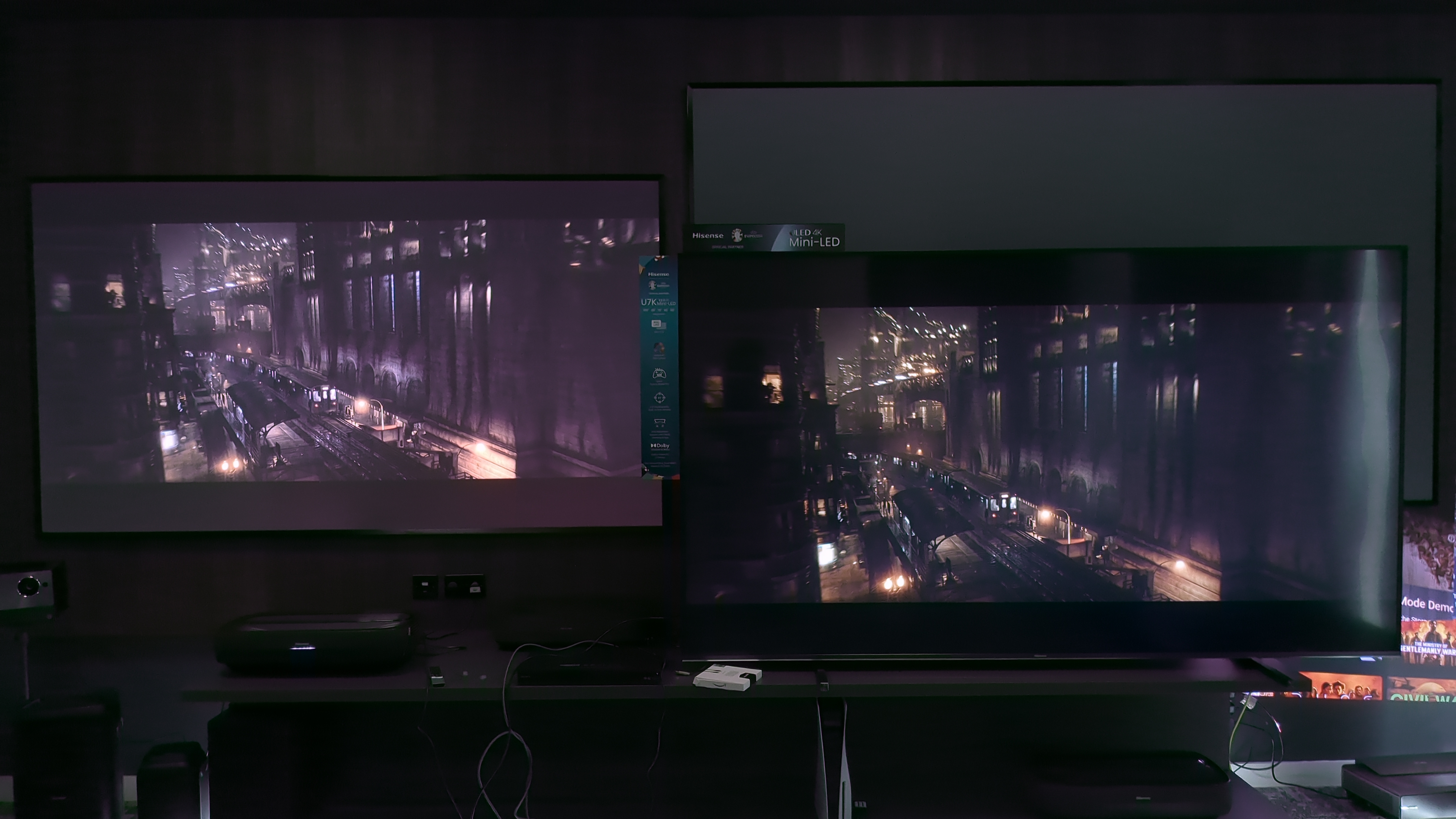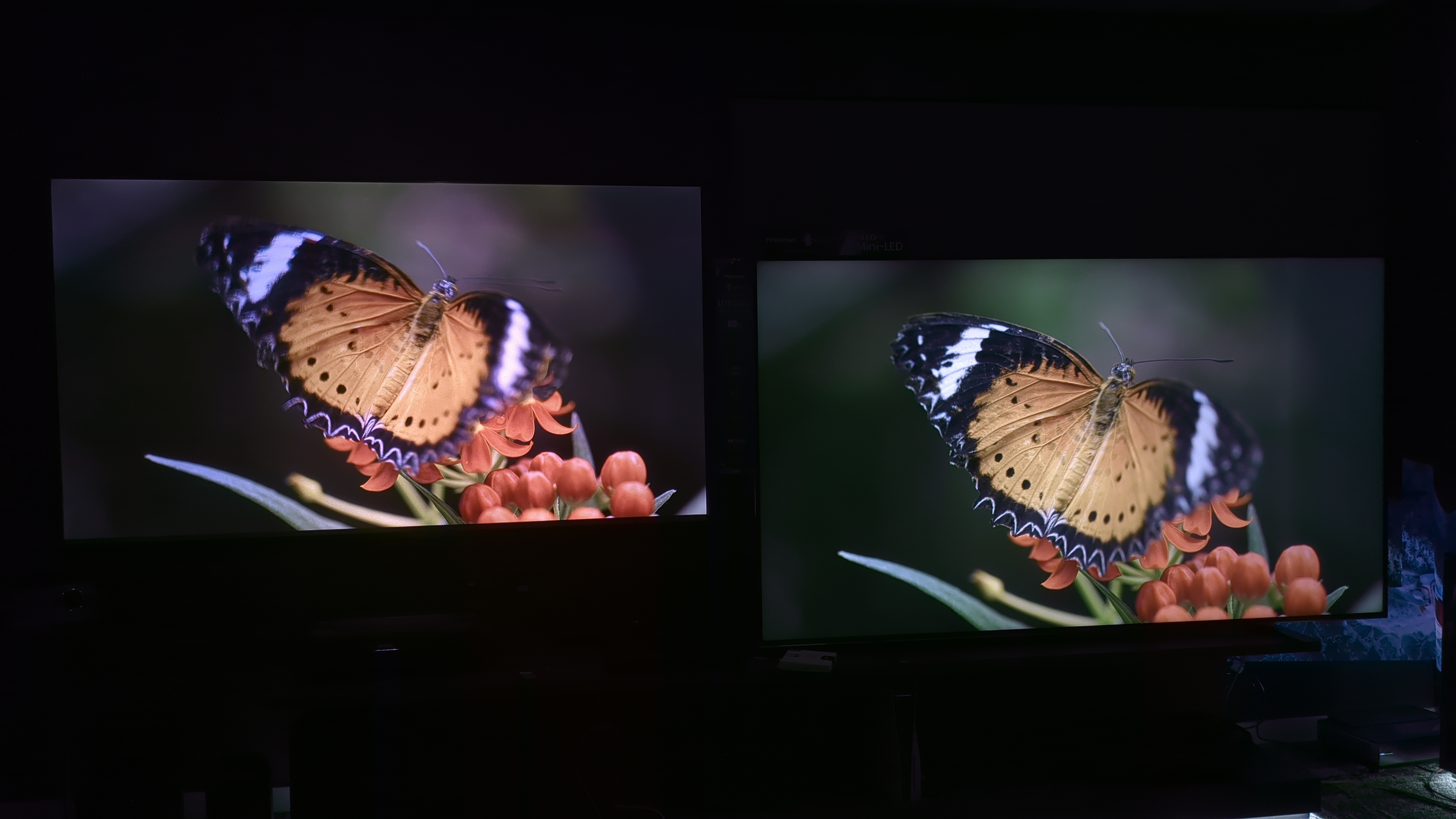Want a big home theater screen on a budget? I tested a 100-inch TV and a 100-inch ultra short throw projector side by side and here's what I learned
Which tech should home theater fans choose?

It’s always a tough choice for home theater fans to make – TV or projector? Until recent years, a projector has generally been the best way to get the big-screen home theater experience for the money (and arguably still is), with giant TVs often selling at extraordinary prices.
However, the last couple of years have seen a thriving market of 98, 100 and even now 110-inch TVs hit affordable prices, while also delivering performance rivaling that of a projector. Some of the best TVs in this ultra-large screen segment come from brands that are all about bang for your buck such as TCL and Hisense.
The best ultra short throw projectors are another popular product that has entered the market in recent years. These carry the benefits of a projector (large image size) but without the stringent setup requirements associated with traditional long throw models, and can be placed mere inches away from the screen they’re projecting onto. Ultra short throw projectors often use a laser light source, which brings the benefits of high brightness, long life and typically wide color gamuts.
Hisense is one brand that offers products in both the projector and TV categories, again focusing on the value for money aspect. But, of the two display types, which is better for home theater?
For Home Theater Week here at TechRadar, I was given an opportunity by Hisense to test one of its ‘Laser TV’ ultra short throw projectors, the 100-inch L9H, and a 100-inch U7K big-screen TV side-by-side to compare the differences. Both of these products are priced relatively similarly, with the 100L9H at $3,799 / £3,999 / AU$7,495 and the 100U7K at roughly $2,999 / £2,999 / AU$6,995. For the image size you’re getting, those are budget prices – but which one should you invest your money in?
It's worth noting that for the photos in this article, the Hisense L9H UST projector (on the left in all photos) did not have the red tint shown – a result of the camera's shutter speed capturing the laser of the projector. In person, the projector's image looked closer to that of the U7K TV.
Comparing colors

I started my comparison with a 4K Dolby Vision stream of Star Wars: The Last Jedi via Disney Plus – a movie I often use when testing and reviewing TVs. With both the L9H projector and U7K TV set to Dolby Vision Dark picture mode, I used the throne room fight scene, which features vibrant reds throughout, and found my eye drawn to the L9H projector over the U7K TV, with the reds within the scene appearing punchier, deeper and bolder overall.
Get daily insight, inspiration and deals in your inbox
Sign up for breaking news, reviews, opinion, top tech deals, and more.
Moving onto brighter content, I watched a 4K HDR scene from Amazon Prime’s Rings of Power where we get our first look at Numenor. I found that the L9H struggled with the brighter-hued colors and that the reflections off the sand-colored stone statues appeared more natural on the U7K. Here again, though, the L9H’s handling of bold colors drew the eye more, despite the projector’s lower overall brightness. Both devices were set to Filmmaker Mode and despite the L9H’s more eye-catching colors, the U7K displayed a more natural color palette.
During my viewing of the Numenor scene from Rings of Power, I explored different picture modes on the L9H and was surprised to find that the HDR Dynamic mode, which sharpened textures to TV-like levels, was one of its best. Some may prefer the more toned-down appearance of other picture modes like Filmmaker Mode, but I was impressed with just how good Dynamic mode looked.
I have generally preferred TVs to projectors before due to their crisper rendering of textures and deeper black levels. But interestingly, the L9H in scenes from both Star Wars and Rings of Power had the crisper detail of the two, regardless of what picture mode it was in.
In the dark

I next watched several scenes from The Batman. This movie was mastered at 400 nits (most movies are mastered at 1,000 or even 4,000 nits) and can be a real test of a display’s black levels and shadow detail. Although I knew neither would rival the best OLED TVs, I was impressed by the performance of both.
Ultimately, I found that the L9H UST projector suited The Batman’s grainy, gloomy tone better. In the opening crime scene, contrast was richer on the L9H, which displayed a better balance between the dimly lit corridor and the lamps and bulbs of the cameras. Black levels were also deeper and more accurate on the L9H. This isn’t to say the U7K didn’t also have strong contrast and deep black levels, but blooming effects from the U7K’s mini-LED backlight weakened darker tones on the TV.
One thing I did note was that the L9H was more prone to black crush, resulting in a loss of detail on characters' clothing and other objects. The U7K, in contrast, managed to retain those details throughout.
Hisense L9H projector vs U7N TV – which is best?

It’s worth noting that neither of these displays are perfect. Also, neither is top in their respective categories; there are more premium, higher-performance ultra-large screen TVs and ultra short throw projectors available. But, both make the home theater dream more of a reality by providing more affordable (by home theater standards) big-screen options.
Although I still am more of a fan of TVs, in this budget big-screen situation I found myself drawn to the Hisense L9H Laser TV projector. Its colors looked bolder, more realistic, and more dynamic overall. It also did a better job handling darker shadows and blacks and had overall richer contrast. Textures and details were fantastic on both, but on the L9H they were surprisingly crisper.
That’s not to say the U7K was bad – far from it. It still displayed natural textures, punchy colors and deep black levels that years ago would not have been possible in this size and at this price. It is one of several budget 90-inch-plus TVs that prove you don’t have to settle for a projector if you don’t want one.
It’s worth mentioning that these tests were conducted in a light-controlled environment with fairly thick, but not blackout, curtains and no lights on. When I opened the curtains, the U7K with its higher brightness did a better job in the more brightly lit environment. But the L9H fared better in more ideal home theater viewing conditions.
If you're looking to get a home theater-sized screen, projectors and TVs are both now a budget-friendly option. In my case, of these two Hisense displays, I’d opt for the L9H projector – but only just.

James is the TV Hardware Staff Writer at TechRadar. Before joining the team, he worked at a major UK based AV retailer selling TV and audio equipment, where he was either telling customers the difference between OLED and QLED or being wowed by watching a PS5 run on the LG 65G2. When not writing about the latest TV tech, James can be found gaming, reading, watching rugby or coming up with another idea for a novel.